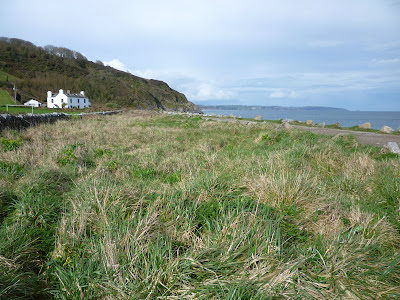Yesterday the DBWPS meeting started at West Charleton Marsh, a new site for me on the Kingsbridge estuary. It was a sociable & environmentally friendly trip as I car-shared with 3 other lady birders. Amazingly it turned out that Pamela, who was driving, already knows Simon from the Monday East Budleigh art class! The other 'crew' members were Libby, who I'd met on the Broadsands trip & Rosemary who's just taken up birding.
 |
| Location of West Charleton Marsh |
13 of us met up at 10:00 & after risking life & limb to cross the A379, we stopped to scan the marsh from the reserve access road. Straight away I got myself a new Year bird!
An Egyptian Goose was nibbling the vegetation in the middle of the marsh, what a good start! We then walked
past a small sewage works - birders must be the only people in the world that
actually like them. There were
quite a few birds about, including 2 female Blackcaps, and several Chiffchaffs & Cirl Buntings. A vast cloud of midges was swirling about at
the top of a fir tree, but unfortunately there were no swallows tucking in.
 |
| The sewage works gets some attention |
We walked through the marsh towards the hide, getting closer views of the Egyptian Goose as we went. There were loads of Little Egrets & quite a few Herons, some Teal & a couple of female Wigeon. It was a 'double aspect' hide, looking over the marsh one way & the estuary the other. It was also a luxury hide..... I've never been in one with cushions before!
 |
| The 'double aspect' hide |
 |
| A touch of comfort..... |
A snipe was found hiding behind some reeds on the marsh & out on the estuary was a small flock of Brent Geese, some Red-breasted Mergansers, and a lonely Redshank. On the distant shore across the water we got excited when we thought we'd found an otter, or was it a seal? No it was a bird at an odd angle.
 |
| Part of the Kingsbridge estuary from the hide |
We went onto the beach near the hide to inspect some distant waders, which we decided were probably curlew, before walking back through the marsh. It had been a bit nippy & overcast, but then a bit of blue sky appeared along with 7 Buzzards.
 |
| A bit of blue sky....... |
By now it was almost lunchtime, so we returned to the cars & most of us headed off to Beesands where we had lunch in the car park. Alan spotted a Long-tailed Tit's nest in the brambles beside the car park, although still under construction it was already quite impressive. The forecast had been for rain in the afternoon & we did get a little sprinkle as we walked to the hide, but it only lasted a few minutes.
Looking out across Widdicombe Ley, David spotted 3 birds on the other side, repeatedly flying up & landing back on the roof of a building. They were Wheatears! My first of the year, in fact probably everyone's first as they've only just started turning up having been in Africa for the winter. Great! There were several Chiffchaffs right in front of the hide, at least 2 of which had black patches above & below their beaks. We couldn't work out whether they'd been eating black berries, maybe ivy, dyeing their feathers, or whether it was some sort of genetic mutation. There were a few ducks, including Tufted & Pochards, and some entertaining Shovelers swimming in tight circles in pairs to stir up the water as they fed. After a while, Alan spotted a Black Redstart on the far side of the Ley! It kept flying up giving us fabulous views of his red tail.
 |
| Widdicombe Ley at Beesands |
We walked around to the other side of the Ley to get a closer view of the Wheatears & Black Redstart. There were in fact 4 Wheatears, 3 female & 1 male which gave us great views on the roof and the adjacent football field. Out to sea there was a male Common Scoter quite close in, giving me the best view I've had of one & showing off its distinctive yellow bill patch.There were also 2 Slavonian Grebes further off to the South.
 |
| Widdicombe Ley from the sea side. |
 |
| Looking North towards Dartmouth |
Some of the group went on to Slapton, but we headed back to Exmouth. It had been an excellent day. I had 62 species on my list, although I think I probably missed a few. Two new Year List birds puts me on 144 & 1 Sub-Species.










No comments:
Post a Comment